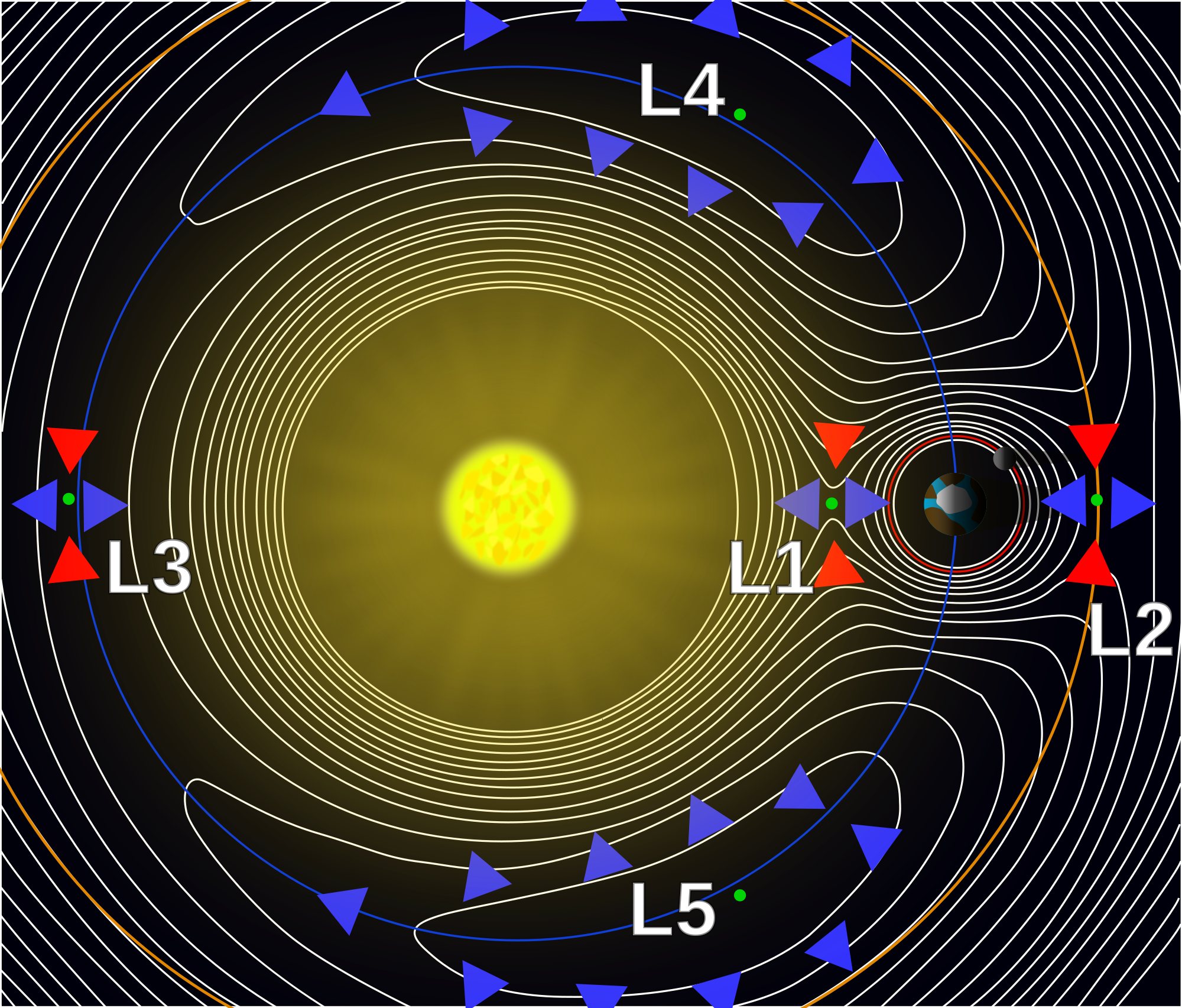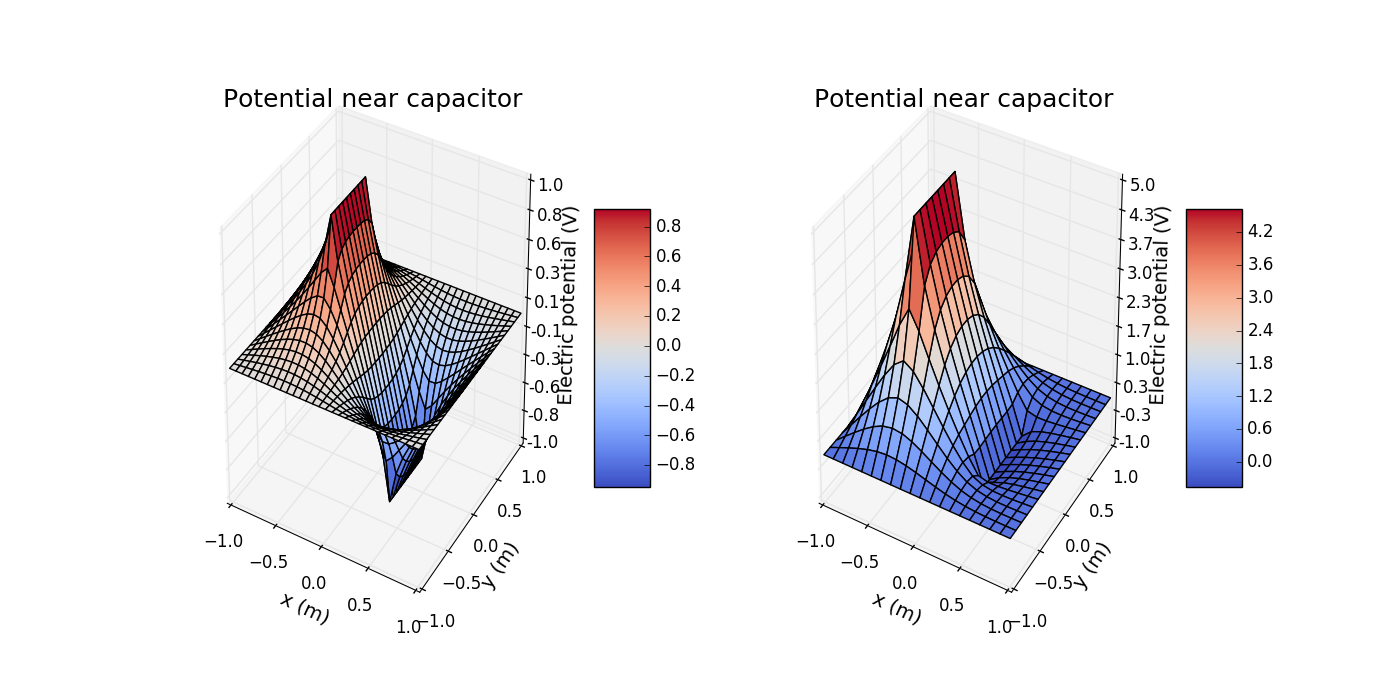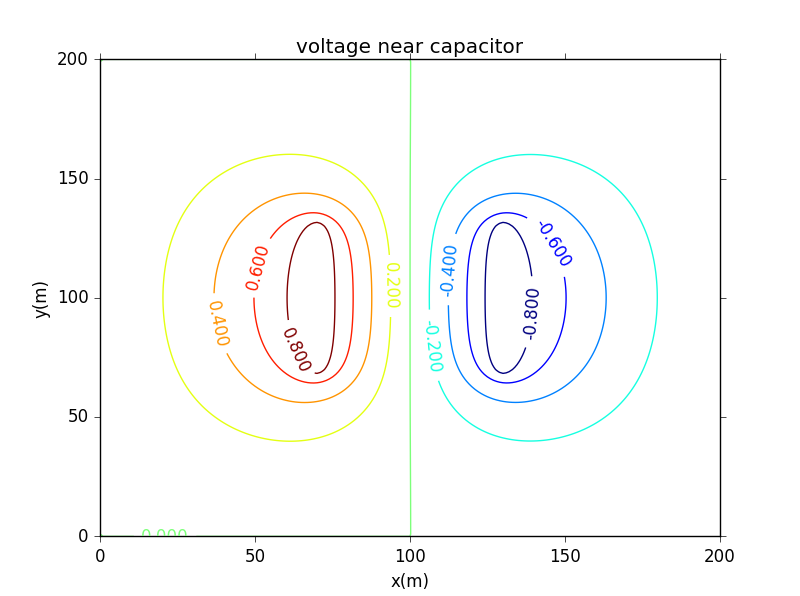@wudawufanfan
2016-12-11T14:08:47.000000Z
字数 19511
阅读 535
Potentials and Fields

electric potential and fields:laplace's equation
In regions of space that do not contain any electric charges,the electric potential obeys Laplace's equation
Our problem is to find the function V(x,y,z) that satisfies both Laplace's equation and the specified boundary conditions.
As usual we discretize the independent variables,in the case x,y and z.Points in our space are then specified by integers i,j,k.Our goal is to determine the potential on this lattice of points.
is we set
Inserting them all into Laplace's equation and solving for V(i,j,k) we find
FIGURE:Schematic flowchart for the relaxation algorithm
the problem of calculating the electric potential inside the square box
the boundary conditions we assume that the face of the box at x=-1 is held at V=-1,while V=+1 on the face at x=1. and V(i,j,k) is independent of k.
Jacobi Method (via wikipedia):
An algorithm for determining the solutions of a diagonally dominant system of linear equations. Each diagonal element is solved for, and an approximate value is plugged in. The process is then iterated until it converges. This algorithm is a stripped-down version of the Jacobi transformation method of matrix diagonalization.
In other words, Jacobi’s method is an iterative method for solving systems of linear equations, very similar to Gauss-Seidel Method. Beginning with the standard Ax = b, where A is a known matrix and b is a known vector we can use Jacobi’s method to approximate/solve x. The one caveat being the A matrix must be diagonally dominant to ensure that the method converges, although it occasionally converges without this condition being met.
import numpy as npfrom scipy.linalg import solvedef jacobi(A, b, x, n):D = np.diag(A)R = A - np.diagflat(D)for i in range(n):x = (b - np.dot(R,x))/ Dreturn x'''___Main___'''A = np.array([[4.0, -2.0, 1.0], [1.0, -3.0, 2.0], [-1.0, 2.0, 6.0]])b = [1.0, 2.0, 3.0]x = [1.0, 1.0, 1.0]n = 25x = jacobi(A, b, x, n)print (solve(A, b))init [1.0, 1.0, 1.0]000 [ 0.5 0.33333333 0.33333333]001 [ 0.33333333 -0.27777778 0.47222222]002 [-0.00694444 -0.24074074 0.64814815]003 [-0.03240741 -0.23688272 0.57908951]004 [-0.01321373 -0.29140947 0.57355967]005 [-0.03909465 -0.28869813 0.5949342 ]006 [-0.04308262 -0.28307542 0.58971694]007 [-0.03896694 -0.28788291 0.58717804]008 [-0.04073597 -0.28820362 0.58946648]009 [-0.04146843 -0.28726767 0.58927855]010 [-0.04095347 -0.28763711 0.58884448]011 [-0.04102968 -0.28775483 0.58905346]012 [-0.04114078 -0.28764092 0.58908 ]013 [-0.04109046 -0.28766026 0.58902351]014 [-0.04108601 -0.28768115 0.58903834]015 [-0.04110016 -0.28766977 0.58904605]016 [-0.0410964 -0.28766935 0.5890399 ]017 [-0.04109465 -0.2876722 0.58904039]018 [-0.0410962 -0.28767129 0.58904162]019 [-0.04109605 -0.28767098 0.58904107]020 [-0.04109576 -0.28767131 0.58904099]021 [-0.0410959 -0.28767126 0.58904114]022 [-0.04109592 -0.2876712 0.5890411 ]023 [-0.04109588 -0.28767124 0.58904108]024 [-0.04109589 -0.28767124 0.5890411 ]Sol [-0.04109589 -0.28767124 0.5890411 ]Act [-0.04109589 -0.28767123 0.5890411 ]
Now we consider two complicated cases where an analytic solution is difficult.
A long infinitely long,hollow prism,with metallic walls and a square cross-section.The prism and inner conductor are presumed to be infinite in extent along z,The inner conductor is held at V=1 and the walls of the prism at V=0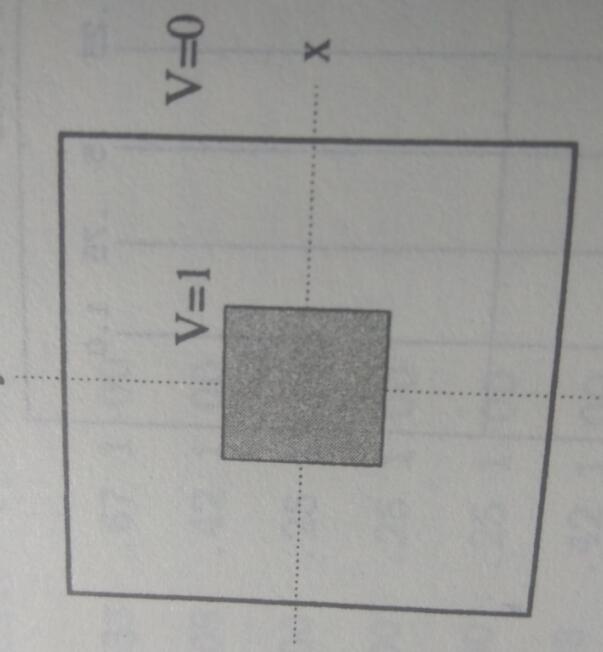
Another example is two capacitor plates held at V=1(left plate) and V=-1(right plate).The square boundary surrounding the plates is held at V=0
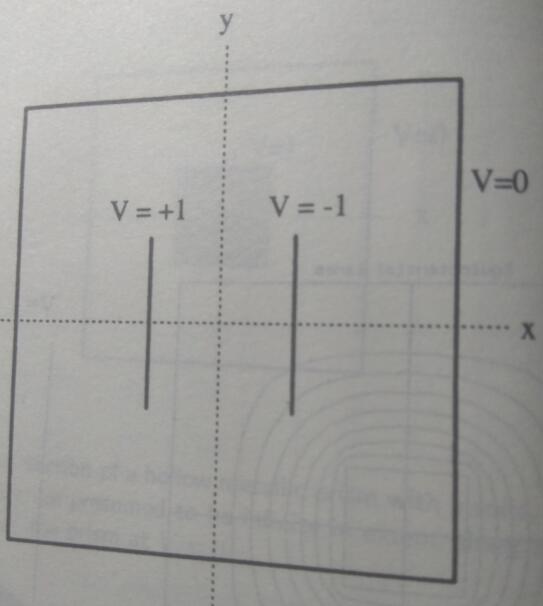
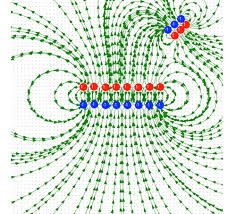
from numpy import *import mpl_toolkits.mplot3dimport matplotlib.pyplot as pltfrom matplotlib import cmfrom matplotlib.ticker import LinearLocator, FormatStrFormatter'''class Electric_Fieldthis class solves the potential euation of capacitorwhere:V1: potential of the left plateV2: potential of the right palten: size of one side'''class ELECTRIC_FIELD(object):def __init__(self, V1=1, V2=-1, V_boundary=0, n=30):self.V1=float(V1)self.V2=float(V2)self.V_boundary=float(V_boundary)self.n=int(n)self.s1, self.s3=int(n/3), int(n/3)self.s2, self.s4=int(self.n-2-2*self.s1), int(self.n-2*self.s3)self.V=[]for j in range(self.n):self.V.append([0.0]*self.n)for j in [0,self.n-1]:self.V[j]=[self.V_boundary]*self.nfor j in range(self.s3,self.s3+self.s4):self.V[j][self.s1]=self.V1self.V[j][self.s1+self.s2+1]=self.V2def update_V_SOR(self): # use SOR method solve the potentialself.alpha=2./(1.+pi/self.n)self.counter=0while True:self.delta_V=0.for j in range(1,self.n-1):for i in range(1,self.n-1):if (j in range(self.s3,self.s3+self.s4)) and (i in [self.s1,self.s1+self.s2+1]):continueself.next_V=1./4.*(self.V[j-1][i]+self.V[j+1][i]+self.V[j][i-1]+self.V[j][i+1])self.V[j][i]=self.alpha*(self.next_V-self.V[j][i])+self.V[j][i]self.delta_V=self.delta_V+abs(self.alpha*(self.next_V-self.V[j][i]))self.counter=self.counter+1if (self.delta_V < abs(self.V2-self.V1)*(1.0E-5)*self.n*self.n and self.counter >= 10):breakprint ('itertion length n=',self.n,' ',self.counter,' times')def Ele_field(self,x1,x2,y1,y2): # calculate the Electirc fieldself.dx=abs(x1-x2)/float(self.n-1)self.Ex=[]self.Ey=[]for j in range(self.n):self.Ex.append([0.0]*self.n)self.Ey.append([0.0]*self.n)for j in range(1,self.n-1,1):for i in range(1,self.n-1,1):self.Ex[j][i]=-(self.V[j][i+1]-self.V[j][i-1])/(2*self.dx)self.Ey[j][i]=-(self.V[j-1][i]-self.V[j+1][i])/(2*self.dx)def plot_3d(self,ax,x1,x2,y1,y2): # give 3d plot the potentialself.x=linspace(x1,x2,self.n)self.y=linspace(y2,y1,self.n)self.x,self.y=meshgrid(self.x,self.y)self.surf=ax.plot_surface(self.x,self.y,self.V, rstride=1, cstride=1, cmap=cm.coolwarm)ax.set_xlim(x1,x2)ax.set_ylim(y1,y2)ax.zaxis.set_major_locator(LinearLocator(10))ax.zaxis.set_major_formatter(FormatStrFormatter('%.01f'))ax.set_xlabel('x (m)',fontsize=14)ax.set_ylabel('y (m)',fontsize=14)ax.set_zlabel('Electric potential (V)',fontsize=14)ax.set_title('Potential near capacitor',fontsize=18)def plot_2d(self,ax1,ax2,x1,x2,y1,y2): # give 2d plot of potential and electric fieldself.x=linspace(x1,x2,self.n)self.y=linspace(y2,y1,self.n)self.x,self.y=meshgrid(self.x,self.y)cs=ax1.contour(self.x,self.y,self.V)plt.clabel(cs, inline=1, fontsize=10)ax1.set_title('Equipotential lines',fontsize=18)ax1.set_xlabel('x (m)',fontsize=14)ax1.set_ylabel('y (m)',fontsize=14)for j in range(1,self.n-1,1):for i in range(1,self.n-1,1):ax2.arrow(self.x[j][i],self.y[j][i],self.Ex[j][i]/40,self.Ey[j][i]/40,fc='k', ec='k')ax2.set_xlim(-1.,1.)ax2.set_ylim(-1.,1.)ax2.set_title('Electric field',fontsize=18)ax2.set_xlabel('x (m)',fontsize=14)ax2.set_ylabel('y (m)',fontsize=14)def export_data(self,x1,x2,y1,y2):self.mfile=open(r'd:\data.txt','w')self.x=linspace(x1,x2,self.n)self.y=linspace(y2,y1,self.n)self.x,self.y=meshgrid(self.x,self.y)for j in range(self.n):for i in range(self.n):print >> self.mfile, self.x[j][i],self.y[j][i],self.V[j][i]self.mfile.close()# give plot of potential and electric fieldfig=plt.figure(figsize=(10,5))ax1=plt.axes([0.1,0.1,0.35,0.8])ax2=plt.axes([0.55,0.1,0.35,0.8])cmp=ELECTRIC_FIELD(1,-1,0,20)cmp.update_V_SOR()cmp.Ele_field(-1,1,-1,1)cmp.plot_2d(ax1,ax2,-1.,1.,-1.,1.)plt.show()# give 3d plot of potentialfig=plt.figure(figsize=(14,7))ax1= plt.subplot(1,2,1,projection='3d')cmp=ELECTRIC_FIELD()cmp.update_V_SOR()cmp.plot_3d(ax1,-1.,1.,-1.,1.)fig.colorbar(cmp.surf, shrink=0.5, aspect=5)ax2= plt.subplot(1,2,2,projection='3d')cmp=ELECTRIC_FIELD(5,-0.5,0,20)cmp.update_V_SOR()cmp.plot_3d(ax2,-1.,1.,-1.,1.)fig.colorbar(cmp.surf, shrink=0.5, aspect=5)plt.show(fig)
from __future__ import divisionimport matplotlibimport numpy as npimport matplotlib.cm as cmimport matplotlib.mlab as mlabimport matplotlib.pyplot as pltfrom mpl_toolkits.mplot3d import Axes3D# initialize the gridgrid = []for i in range(201):row_i = []for j in range(201):if i == 0 or i == 200 or j == 0 or j == 200:voltage = 0elif 70<=i<=130 and j == 70:voltage = 1elif 70<=i<=130 and j == 130:voltage = -1else:voltage = 0row_i.append(voltage)grid.append(row_i)# define the update_V function (Gauss-Seidel method)def update_V(grid):delta_V = 0for i in range(201):for j in range(201):if i == 0 or i == 200 or j == 0 or j == 200:passelif 70<=i<=130 and j == 70:passelif 70<=i<=130 and j == 130:passelse:voltage_new = (grid[i+1][j]+grid[i-1][j]+grid[i][j+1]+grid[i][j-1])/4voltage_old = grid[i][j]delta_V += abs(voltage_new - voltage_old)grid[i][j] = voltage_newreturn grid, delta_V# define the Laplace_calculate functiondef Laplace_calculate(grid):epsilon = 10**(-5)*200**2grid_init = griddelta_V = 0N_iter = 0while delta_V >= epsilon or N_iter <= 10:grid_impr, delta_V = update_V(grid_init)grid_new, delta_V = update_V(grid_impr)grid_init = grid_newN_iter += 1return grid_newmatplotlib.rcParams['xtick.direction'] = 'out'matplotlib.rcParams['ytick.direction'] = 'out'x = np.linspace(0,200,201)y = np.linspace(0,200,201)X, Y = np.meshgrid(x, y)Z = Laplace_calculate(grid)plt.figure()CS = plt.contour(X,Y,Z,10)plt.clabel(CS, inline=1, fontsize=12)plt.title('voltage near capacitor')plt.xlabel('x(m)')plt.ylabel('y(m)')fig = plt.figure()ax = fig.add_subplot(111, projection='3d')ax.plot_surface(X, Y, Z)ax.set_xlabel('x(m)')ax.set_ylabel('y(m)')ax.set_zlabel('voltage(V)')ax.set_title('voltage distribution')plt.show()
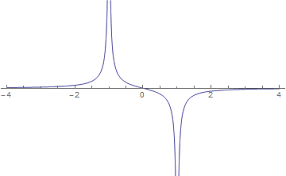
Mathematically the Jacobi method can be expressed as
the simple improvement is the Gasuss-Seidel method.
and we can think of
to speed up convergence we will change potential by a larger amount calculated according to
where is a factor that measures how much we "over-relax"
from numpy import *import mpl_toolkits.mplot3dimport matplotlib.pyplot as pltfrom matplotlib import cmfrom matplotlib.ticker import LinearLocator, FormatStrFormatterimport time'''class Electric_Fieldthis class solves the potential euation of capacitorwhere:V1: potential of the left plateV2: potential of the right palten: size of one side'''class ELECTRIC_FIELD(object):def __init__(self, V1=1, V2=-1, V_boundary=0, n=30):self.V1=float(V1)self.V2=float(V2)self.V_boundary=float(V_boundary)self.n=int(n)self.s1, self.s3=int(n/3), int(n/3)self.s2, self.s4=int(self.n-2-2*self.s1), int(self.n-2*self.s3)self.V=[]for j in range(self.n):self.V.append([0.0]*self.n)for j in [0,self.n-1]:self.V[j]=[self.V_boundary]*self.nfor j in range(self.s3,self.s3+self.s4):self.V[j][self.s1]=self.V1self.V[j][self.s1+self.s2+1]=self.V2def update_V_Jacobi(self):self.counter=0 # use Jacobi method solve the potentialwhile True:self.V_next=[]for j in range(self.n):self.V_next.append([0.0]*self.n)for j in range(self.n):for i in range(self.n):self.V_next[j][i]=self.V[j][i]self.delta_V=0.for j in range(1,self.n-1):for i in range(1,self.n-1):if (j in range(self.s3,self.s3+self.s4)) and (i in [self.s1,self.s1+self.s2+1]):continueself.V_next[j][i]=1./4.*(self.V[j-1][i]+self.V[j+1][i]+self.V[j][i-1]+self.V[j][i+1])self.delta_V=self.delta_V+abs(self.V_next[j][i]-self.V[j][i])self.counter=self.counter+1for j in range(self.n):for i in range(self.n):self.V[j][i]=self.V_next[j][i]if (self.delta_V < abs(self.V2-self.V1)*(1.0E-5)*self.n*self.n and self.counter >= 10):breakprint ('jacobi itertion length n=',self.n,' ',self.counter,' times')return self.counterdef update_V_Gauss(self): # use Gauss-Seidel method solve the potentialself.counter=0while True:self.delta_V=0.for j in range(1,self.n-1):for i in range(1,self.n-1):if (j in range(self.s3,self.s3+self.s4)) and (i in [self.s1,self.s1+self.s2+1]):continueself.next_V=1./4.*(self.V[j-1][i]+self.V[j+1][i]+self.V[j][i-1]+self.V[j][i+1])self.delta_V=self.delta_V+abs(self.next_V-self.V[j][i])self.V[j][i]=self.next_Vself.counter=self.counter+1if (self.delta_V < abs(self.V2-self.V1)*(1.0E-5)*self.n*self.n and self.counter >= 10):breakprint ('gauss itertion length n=',self.n,' ',self.counter,' times')return self.counterdef update_V_SOR(self): # use SOR method solve the potentialself.alpha=2./(1.+pi/self.n)self.counter=0while True:self.delta_V=0.for j in range(1,self.n-1):for i in range(1,self.n-1):if (j in range(self.s3,self.s3+self.s4)) and (i in [self.s1,self.s1+self.s2+1]):continueself.next_V=1./4.*(self.V[j-1][i]+self.V[j+1][i]+self.V[j][i-1]+self.V[j][i+1])self.V[j][i]=self.alpha*(self.next_V-self.V[j][i])+self.V[j][i]self.delta_V=self.delta_V+abs(self.alpha*(self.next_V-self.V[j][i]))self.counter=self.counter+1if (self.delta_V < abs(self.V2-self.V1)*(1.0E-5)*self.n*self.n and self.counter >= 10):breakprint( 'SOR itertion length n=',self.n,' ',self.counter,' times')return self.counterdef Ele_field(self,x1,x2,y1,y2): # calculate the Electirc fieldself.dx=abs(x1-x2)/float(self.n-1)self.Ex=[]self.Ey=[]for j in range(self.n):self.Ex.append([0.0]*self.n)self.Ey.append([0.0]*self.n)for j in range(1,self.n-1,1):for i in range(1,self.n-1,1):self.Ex[j][i]=-(self.V[j][i+1]-self.V[j][i-1])/(2*self.dx)self.Ey[j][i]=-(self.V[j-1][i]-self.V[j+1][i])/(2*self.dx)def plot_3d(self,ax,x1,x2,y1,y2): # give 3d plot the potentialself.x=linspace(x1,x2,self.n)self.y=linspace(y2,y1,self.n)self.x,self.y=meshgrid(self.x,self.y)self.surf=ax.plot_surface(self.x,self.y,self.V, rstride=1, cstride=1, cmap=cm.coolwarm)ax.set_xlim(x1,x2)ax.set_ylim(y1,y2)ax.zaxis.set_major_locator(LinearLocator(10))ax.zaxis.set_major_formatter(FormatStrFormatter('%.01f'))ax.set_xlabel('x (m)',fontsize=14)ax.set_ylabel('y (m)',fontsize=14)ax.set_zlabel('Electric potential (V)',fontsize=14)ax.set_title('Potential near capacitor',fontsize=18)def plot_2d(self,ax1,ax2,x1,x2,y1,y2): # give 2d plot of potential and electric fieldself.x=linspace(x1,x2,self.n)self.y=linspace(y2,y1,self.n)self.x,self.y=meshgrid(self.x,self.y)cs=ax1.contour(self.x,self.y,self.V)plt.clabel(cs, inline=1, fontsize=10)ax1.set_title('Equipotential lines',fontsize=18)ax1.set_xlabel('x (m)',fontsize=14)ax1.set_ylabel('y (m)',fontsize=14)for j in range(1,self.n-1,1):for i in range(1,self.n-1,1):ax2.arrow(self.x[j][i],self.y[j][i],self.Ex[j][i]/40,self.Ey[j][i]/40,fc='k', ec='k')ax2.set_xlim(-1.,1.)ax2.set_ylim(-1.,1.)ax2.set_title('Electric field',fontsize=18)ax2.set_xlabel('x (m)',fontsize=14)ax2.set_ylabel('y (m)',fontsize=14)def export_data(self,x1,x2,y1,y2): # export dataself.mfile=open(r'd:\data.txt','w')self.x=linspace(x1,x2,self.n)self.y=linspace(y2,y1,self.n)self.x,self.y=meshgrid(self.x,self.y)for j in range(self.n):for i in range(self.n):print >> self.mfile, self.x[j][i],self.y[j][i],self.V[j][i]self.mfile.close()# compare three methodn_min=10 # Jacobi methodn_max=50n_jacobi=[]iters_jacobi=[]time_jacobi=[]for i in range(n_min,n_max,2):start=time.clock()cmp=ELECTRIC_FIELD(1,-1,0,i)iters_jacobi.append(cmp.update_V_Jacobi())end=time.clock()time_jacobi.append(end-start)n_jacobi.append(i)n_gauss=[] # Gauss Seidel methoditers_gauss=[]time_gauss=[]for i in range(n_min,n_max,2):start=time.clock()cmp=ELECTRIC_FIELD(1,-1,0,i)iters_gauss.append(cmp.update_V_Gauss())end=time.clock()time_gauss.append(end-start)n_gauss.append(i)n_SOR=[] # SOR methoditers_SOR=[]time_SOR=[]for i in range(n_min,n_max,2):start=time.clock()cmp=ELECTRIC_FIELD(1,-1,0,i)iters_SOR.append(cmp.update_V_SOR())end=time.clock()time_SOR.append(end-start)n_SOR.append(i)print( time_SOR)# export datamfile=open(r'd:\data.txt','w')for i in range(len(n_jacobi)):print ( n_jacobi[i], time_jacobi[i], time_gauss[i], time_SOR[i],file=mfile)mfile.close()# give a simple plotfig=plt.figure(figsize=(14,7))ax1=plt.axes([0.1,0.1,0.35,0.8])ax2=plt.axes([0.55,0.1,0.35,0.8])ax1.plot(n_jacobi,iters_jacobi,'or',markersize=5)ax1.plot(n_gauss,iters_gauss,'ob',markersize=5)ax1.plot(n_SOR,iters_SOR,'oy',markersize=5)ax2.plot(n_jacobi,time_jacobi,'or',markersize=5)ax2.plot(n_gauss,time_gauss,'ob',markersize=5)ax2.plot(n_SOR,time_SOR,'oy',markersize=5)plt.show(fig)
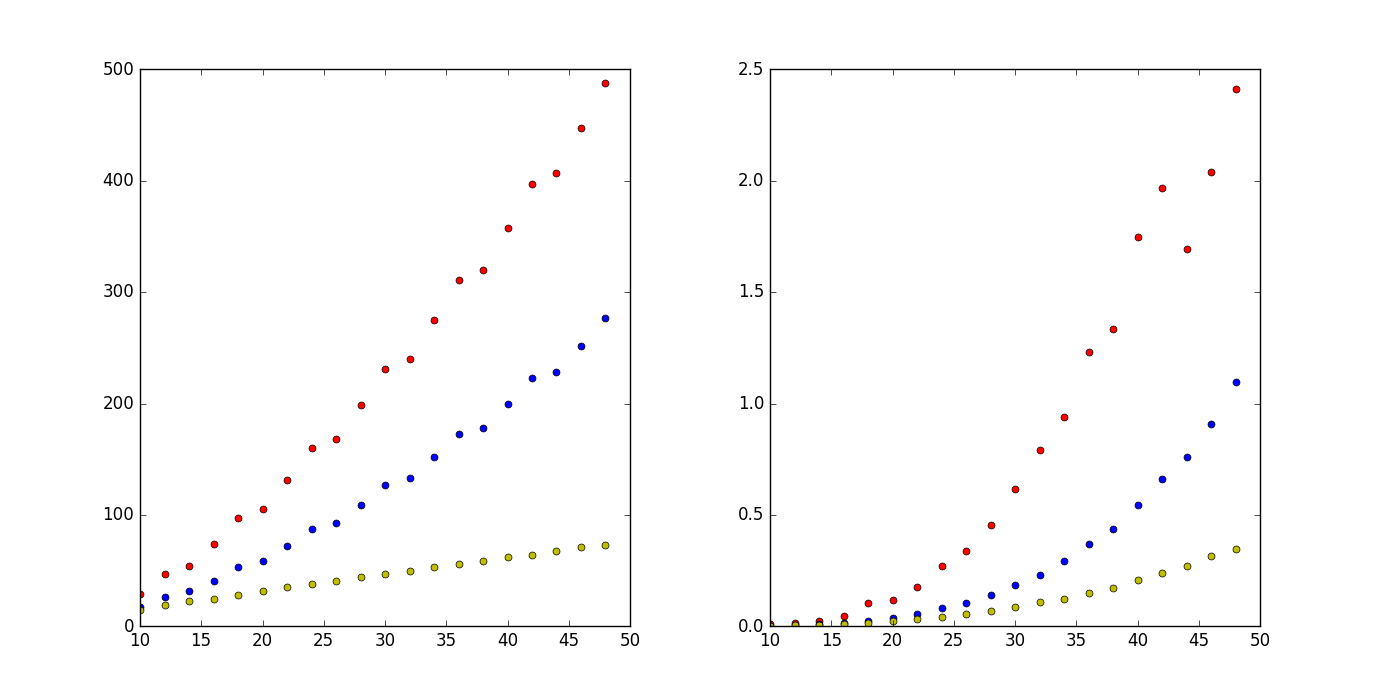
the relation of side length and number of interations(left) time
consuming(right)
from numpy import *import mpl_toolkits.mplot3dimport matplotlib.pyplot as pltfrom matplotlib import cmfrom matplotlib.ticker import LinearLocator, FormatStrFormatterimport time'''class Electric_Fieldthis class solves the potential euation of capacitorwhere:V1: potential of the left plateV2: potential of the right palten: size of one side'''class ELECTRIC_FIELD(object):def __init__(self, V1=1, V2=-1, V_boundary=0, n=30):self.V1=float(V1)self.V2=float(V2)self.V_boundary=float(V_boundary)self.n=int(n)self.s1, self.s3=int(n/3), int(n/3)self.s2, self.s4=int(self.n-2-2*self.s1), int(self.n-2*self.s3)self.V=[]for j in range(self.n):self.V.append([0.0]*self.n)for j in [0,self.n-1]:self.V[j]=[self.V_boundary]*self.nfor j in range(self.s3,self.s3+self.s4):self.V[j][self.s1]=self.V1self.V[j][self.s1+self.s2+1]=self.V2def update_V_SOR(self,alpha): # use SOR method solve the potentialself.alpha=float(alpha)self.counter=0while True:self.delta_V=0.for j in range(1,self.n-1):for i in range(1,self.n-1):if (j in range(self.s3,self.s3+self.s4)) and (i in [self.s1,self.s1+self.s2+1]):continueself.next_V=1./4.*(self.V[j-1][i]+self.V[j+1][i]+self.V[j][i-1]+self.V[j][i+1])self.delta_V=self.delta_V+abs(self.alpha*(self.next_V-self.V[j][i]))self.V[j][i]=self.alpha*(self.next_V-self.V[j][i])+self.V[j][i]self.counter=self.counter+1if (self.delta_V < abs(self.V2-self.V1)*(1.0E-5)*self.n*self.n and self.counter >= 10):breakprint ('SOR itertion alpha= ',self.alpha,' ',self.counter,' times')return self.counterdef Ele_field(self,x1,x2,y1,y2): # calculate the Electirc fieldself.dx=abs(x1-x2)/float(self.n-1)self.Ex=[]self.Ey=[]for j in range(self.n):self.Ex.append([0.0]*self.n)self.Ey.append([0.0]*self.n)for j in range(1,self.n-1,1):for i in range(1,self.n-1,1):self.Ex[j][i]=-(self.V[j][i+1]-self.V[j][i-1])/(2*self.dx)self.Ey[j][i]=-(self.V[j-1][i]-self.V[j+1][i])/(2*self.dx)def plot_3d(self,ax,x1,x2,y1,y2): # give 3d plot the potentialself.x=linspace(x1,x2,self.n)self.y=linspace(y2,y1,self.n)self.x,self.y=meshgrid(self.x,self.y)self.surf=ax.plot_surface(self.x,self.y,self.V, rstride=1, cstride=1, cmap=cm.coolwarm)ax.set_xlim(x1,x2)ax.set_ylim(y1,y2)ax.zaxis.set_major_locator(LinearLocator(10))ax.zaxis.set_major_formatter(FormatStrFormatter('%.01f'))ax.set_xlabel('x (m)',fontsize=14)ax.set_ylabel('y (m)',fontsize=14)ax.set_zlabel('Electric potential (V)',fontsize=14)ax.set_title('Potential near capacitor',fontsize=18)def plot_2d(self,ax1,ax2,x1,x2,y1,y2): # give 2d plot of potential and electric fieldself.x=linspace(x1,x2,self.n)self.y=linspace(y2,y1,self.n)self.x,self.y=meshgrid(self.x,self.y)cs=ax1.contour(self.x,self.y,self.V)plt.clabel(cs, inline=1, fontsize=10)ax1.set_title('Equipotential lines',fontsize=18)ax1.set_xlabel('x (m)',fontsize=14)ax1.set_ylabel('y (m)',fontsize=14)for j in range(1,self.n-1,1):for i in range(1,self.n-1,1):ax2.arrow(self.x[j][i],self.y[j][i],self.Ex[j][i]/40,self.Ey[j][i]/40,fc='k', ec='k')ax2.set_xlim(-1.,1.)ax2.set_ylim(-1.,1.)ax2.set_title('Electric field',fontsize=18)ax2.set_xlabel('x (m)',fontsize=14)ax2.set_ylabel('y (m)',fontsize=14)def export_data(self,x1,x2,y1,y2):self.mfile=open(r'd:\data.txt','w')self.x=linspace(x1,x2,self.n)self.y=linspace(y2,y1,self.n)self.x,self.y=meshgrid(self.x,self.y)for j in range(self.n):for i in range(self.n):print >> self.mfile, self.x[j][i],self.y[j][i],self.V[j][i]self.mfile.close()# change alpha and determine the number of iterationsiters=[]alpha=[]for j in linspace(0.19,0.9,30):cmp=ELECTRIC_FIELD()alpha.append(j)iters.append(cmp.update_V_SOR(j))for j in linspace(0.91,1.3,20):cmp=ELECTRIC_FIELD()alpha.append(j)iters.append(cmp.update_V_SOR(j))for j in linspace(1.3,1.79,30):cmp=ELECTRIC_FIELD()alpha.append(j)iters.append(cmp.update_V_SOR(j))for j in linspace(1.8,1.98,30):cmp=ELECTRIC_FIELD()alpha.append(j)iters.append(cmp.update_V_SOR(j))mfile=open(r'd:\data.txt','w')for i in range(len(alpha)):print(alpha[i],iters[i],file=mfile)mfile.close()fig=plt.figure(figsize=(8,8))ax1=plt.subplot(111)ax1.plot(alpha,iters,'ob')ax1.set_xlabel('alpha')ax1.set_ylabel('number of iterations')plt.show(fig)

the relation between alpha and number of interations
we can find when is around 1.5 to 2,we need the least work.
Thanks
Wu yuqiao and chengyaoyang's codes
Computational physics by Nicholas J.Giordano,Hisao Nakanishi
